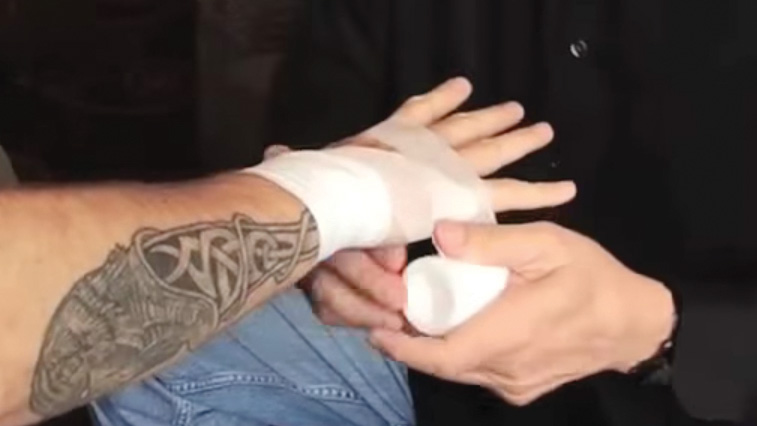
Issue 148
December 2016
The best in the business ‘Stitch’ Duran shows how your hands should be properly prepared for battle.
When you consider that a quarter of your bones are in your hands – with 27 making up each fist – it’s no wonder hand injuries are so prevalent in MMA.
Having your hands wrapped properly is a must for a fight if you don’t want to spend the next few months nursing a break or fracture.
With that in mind, the best-known and most respected cutman in the fight game, ‘Stitch’ Duran, presents his masterclass in mitt wrapping.
His eight-point plan is as extensive as it gets, which means your cornermen can ensure your weapons receive maximum protection, whether you’re stepping into the cage or you’re just in the gym hitting the heavy bag, your trainer’s pads or sparring partners.
1: Sit your fighter in front of you and get them to straddle a chair with their fist hanging over the back of it in front of you. Start below the wrist and wrap up the arm, away from their body.
“The first thing I do is feel the hands. I like to feel the bones and the ligaments for any problems. And I always ask, ‘How are your hands? Any issues you wanna tell me about?’ Often, fighters will have problems with their wrist, a metacarpal bone or around the thumb, and that’s the type of thing I can try and protect.”

2: Ensure your fighter’s hand is spread wide, then work up towards it before crossing over between the thumb and index f.
“I always start with the right hand, whether it’s a flyweight, a heavyweight, a boxer or an MMA guy. It’s just superstition I guess.
"Usually I’ll use around 15 yards of gauze and 10 yards of tape. That’s pretty standard with most places’ rules and regulations. But that’s just the format – every person is different.”
3: Add some extra padding across the knuckles then wrap over and over, while also crossing above and below the thumb.
“The change I make for a ‘knockout’ wrap is we add a bit more protection and support across the back of the hand, below the knuckles, with extra tape. This just strengthens that area of the hand and allows for more contact.”
4: Each wrap depends on the hand so only use enough gauze to protect it. Too much can be as detrimental as not enough.
“If I was wrapping Joseph Benavidez’s hands, for instance, then it would be very different from wrapping Brock Lesnar’s.
Every hand is different, so commissions allow for that flexibility. The bottom line is, use enough to protect the hands you’re wrapping.”
5: When the knuckles, thumb and wrist are suitably protected add tape around the wrist and then strips between each finger.
“I go between the fingers but make sure it’s not too tight. Commissions also require an inch away from the knuckles.”

6: Add further strips of tape across the back of the hand to add that knockout-wrap extra protection.
“If someone asks for the knockout wrap, well, that only leads to one thing: he’s going blow for blow. And that also tells me how busy I may be outside as well.
"If he’s planning on trading shots then there’s more chance of someone getting cut, so I gotta be ready to work when the bell goes as well.
"Wrapping hands is not only about the fighter preparing physically and mentally, but it’s when I prepare also, by doing some research of my own.”
7: Go through the entire wrapping process once more – up the wrist, between the thumb and around the hand with wide tape.
“I always ask how the wrap is feeling throughout the wrapping process. It’s important it feels comfortable, strong and assured. It should feel like a cast by the time I’m finished, which all adds to the fighter’s confidence.”
8: Cut the excess from the palm to allow maximum flexibility.
“The last thing I do is trim the excess gauze and tape on the inside of the hand. And that’s a wrap.”
...









